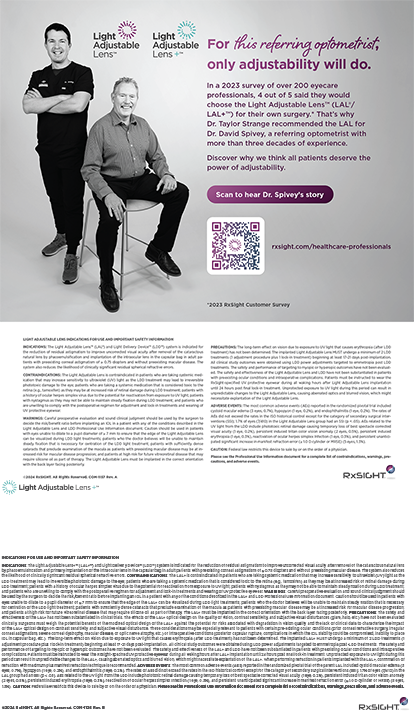Why did you decide to stop performing LASIK?
I have always thought about long-term benefits versus short-term gains in both my professional and personal life. Multiple studies show that severing the trunk of a sensory nerve—anywhere in the body—will eventually kill its peripheral branches. Even if the nerves regenerate, they do not work as well as they did before the injury.1,2
Studies have shown that patients who underwent LASIK have decreased corneal sensation and are more likely to develop dry eye compared with those who underwent surface ablation.3 Given the large number of people who are having LASIK, I think we are setting ourselves up for a major crisis down the line. Fifty-five million people in our country have dry eyes now. What will happen when those who had LASIK are in their 60s, 70s, or 80s? We do not have as severe a problem with surface treatment.
How do you minimize postoperative pain?
I give patients a bottle of anesthetic eye drops to use as needed up to four times a day as well as a topical NSAID. My patients can also alternate acetaminophen and ibuprofen or use a stronger painkiller that I prescribe after surgery. Very few of them complain about severe pain, however, and most say they only experienced moderate discomfort. Many more state that they do not have any pain at all. I think it is also important to manage patients' expectations by telling them up front that they will feel some degree of pain postoperatively.
What was your most challenging refractive case?
In the early 1990s, I saw a patient who needed uncorrected vision of 20/60 to keep his job as an agricultural inspector. At that time, his visual acuity was 20/counts fingers at 2 feet. He was in his mid-30s, had hyperopia of 19.25 D, and had an axial length of 15.80 mm. A straightforward refractive lens exchange would not have helped him because of the size of his eye and the unavailability of IOLs in powers higher than 30.00 D. My solution was to develop the piggyback procedure, in which two IOLs are implanted in the same eye.4
Postoperatively, this patient's uncorrected vision was 20/40. Not only did he keep his job, but getting rid of the thick spectacles he had worn his whole life gave him the confidence he needed to start dating. He ended up getting married soon after his surgery, and he retired from his job with the state of Georgia 2 years ago.
What IOL technologies do you favor?
I really like the AcrySof Toric IOL. I have been correcting astigmatism after cataract surgery with combined procedures for 20 years, and this is the most exciting and dependable lens technology I have seen. I also like wavefront-modified aspheric lenses such as the AcrySof IQ and the Tecnis IOL for occupational drivers or people who have trouble driving in low-light conditions. In addition, I am implanting the AcrySof Restor and ReZoom IOLs in presbyopic patients.
How did you get involved in powerlifting?
I knew I was strong, but I noticed that I seemed to be the strongest person in the various gyms I visited while I was traveling. When I heard about a powerlifting competition in Atlanta in 2006, I decided to give it a try. Even though I only had 6 weeks to train, I ended up placing first in four events, and I set six world records. Since then, I have won 72 titles, 28 of them in July 2007 alone. If I do well at the 2007 American Drug-Free Powerlifting Federation's championship this month, I will be invited to join the national team for the 2007 World Drug-Free Powerlifting Federation's championship, which will be held in Scotland in November. I never thought I would be able to compete with people who devote their whole lives to exercise and physical training, so my success has been very exciting.


